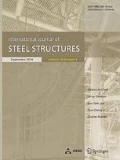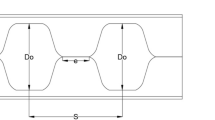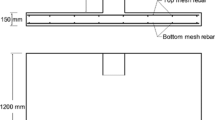Abstract
This paper reviews the design rules of single shear screwed connection of cold-formed steel structure in the current design specifications, such as North American, Australian/New Zealand, European, British, Japanese and Chinese, and points the shortcomings of Chinese design specification and the mistakes of some published reports on the shear resistance of single shear screwed connections. A total of 194 single screw overlap sheared connections, which were made of steel sheet manufactured in China and were tested by Chinese scholars since 1993, and the detailed test data are introduced. Using the design specifications mentioned above recalculated the normal connection shear strength of the 194 connection specimens, and evaluated the accuracy of six design specifications under the different failure modes. The Japanese design manual is too conservative to estimate the bearing capacity of the single shear screwed connection under any failure mode. For tilting or tilting and bearing failure mode, the accuracy of the AISI S100 and AS/NZS 4600 diminishes and sometimes tends to be unsafe; however, the Eurocode 3, BS5950-5 and GB50018 are appropriate. As to screw shear failure mode, the AISI S100, AS/NZS 4600, Eurocode 3 and BS5950-5 are appropriate but GB50018 tends to be unsafe. The paper gives a new design formula as a supplement to GB50018 that can accurately predict the bearing capacity of single shear screwed connection in all failure modes. Finally, the Group Effect of multiple-screw shear connection was investigated based on 38 multiple-screw connection specimens.










Similar content being viewed by others
Abbreviations
- d :
-
Nominal screw diameter
- F u1 :
-
Tensile strength of member in contact with screw head or washer
- F u2 :
-
Tensile strength of member not in contact with screw head or washer
- F y1 :
-
Tensile yield strength of member not in contact with screw head or washer
- P ss :
-
Nominal shear strength per screw as reported by manufacturer or determined by independent laboratory testing
- P ns :
-
Nominal connection shear strength of the connection part limited by both tilting and bearing and by end distance
- t 1 :
-
Thickness of member in contact with screw head or washer
- t 2 :
-
Thickness of member not in contact with screw head or washer
- P T :
-
Test nominal connection shear strength
References
AISI TS-4-02. (2002). Standard test methods for determining the tensile and shear strength of screws. Washington, DC: American Iron and Steel Institute.
AISI S100. (2007). North American specification for the design of cold-formed steel structural members. Washington, DC: American Iron and Steel Institute.
AISI-NAS. (2001). North American specification for the design of cold formed steel structural members. Washington, DC: American Iron and Steel Institute.
AISI-NAS-SUPP. (2004). Supplement 2004 to the North American specification for the design of cold-formed steel structural members. Washington, DC: American Iron and Steel Institute.
AS/NZS 4600. (2005). Cold-formed steel structures. Sydney & Wellington: Australian/New Zealand Standard.
BS5950-5. (1998). Structural use of steelwork in building-Part 5: Code of practice for design of cold-formed thin gauge section. London: British Standard.
EN 1993-1-3. (2006). Eurocode 3 - design of steel structures - part 1-3: general rules supplementary rules for cold-formed members and sheeting. Brussels: European Committee for Standardization.
GB3098.11. (2002). American Iron and Steel Institute. Taiwan: China National Standard.
GB50018. (2002). Technical code of cold-formed thin-wall steel structures. Wuhan: Hubei province development planning commission.
Guidebook on thin sheet and lightweight steel construction. (2002). National Institute for Land and Infrastructure Management, Ministry of Land, Infrastructure, Transport and Tourism. Building Research Institute/Japan Iron and Steel Federation.
Hao, J., Liu, B., Shao, D., et al. (2014). Experimental study on shear behavior of screw connections in cold-formed thin-wall steel structures. Journal of Xi’an University of Architecture and Technology (Natural Science Edition), 46(6), 769–773.
Huang Chuan. (2003). Experimental Research and finite element analysis on cold-formed thin-wall C steel semi-rigid connections. Chongqing: Chongqing University.
LaBoube, R. A., & Sokol, M. A. (2002). Behavior of screw connections in residential construction. Journal of Structural Engineering, 128(1), 115–118.
Li, Y., Ma, R., Song, Y., et al. (2013). Experimental study on shear behavior of screw connections for cold-formed thin-wall steel structures. Journal of Tongji University (Natural Science), 41(1), 11–19.
Liu Nan. (2007). Research on shear behavior and design method of self-tapping screw connection. Harbin: Harbin Institute of Technology.
Lu, L., Zhang, Y., Fang, W., et al. (2013). Experimental investigation on shear-bearing capacity for self-drilling screw connections of cold-formed thin-walled steel. Journal of Central South University (Natural Science Edition), 144(7), 2997–3005.
Pekoz, T. (1990). Design of cold-formed steel screw connections. In Tenth international specialty conference on cold-formed steel structures, St. Louis, Missouri.
Rogers, C. A., Hancock, G.J. (1997). Screwed connection tests of thin G550 and G300 sheet steels. Research Report No. R761. Department of Civil Engineering, the University of Sydney, Centre for Advanced Structural Engineering. Sydney: The University of Sydney.
Rogers, C. A., & Hancock, G. J. (1999). Screwed connection tests of thin G550 and G300 sheet steels. Journal of Structural Engineering, 125(2), 128–136.
Rogers, C. A., Yang, D., & Hancock, G. J. (2003). Stability and ductility of thin high strength G550 steel members and connections. Thin-Walled Structures, 41(2–3), 149–166.
Serrette, Reynaud, & Peyton, Dean. (2009). Strength of screw connections in cold-formed steel construction. Journal of Structure Engineering, 135(8), 951–958.
Shi, Yu., Wang, S., & Liu, Y. (2014). Research on shear behavior of single tapping screw connection in cold-formed thin-wall steel structures. Journal of Architecture and Civil Engineering., 31(2), 57–64.
Shu, G., & Liang, Y. (2009). Experimental research and calculation study of metal skin shear connection. Journal of Building Structures, 30(2), 77–84.
Yan, Shu, & Young, Ben. (2012). Screwed connections of thin sheet steels at elevated temperatures–Part I: Steady state tests. Engineering Structures, 35, 234–243.
Yu, W. W. (2000). Cold-formed steel design (3rd ed.). New York: Wiley.
Zhu, L., Wang, Z, & Wang, X. (2016). Experimental investigation on shear behavior of screw connections for S350 cold-formed Thin-wall steel structures. In Proceedings of the 25th national symposium on structural engineering, (Vol. 1, pp. 528–534).
Acknowledgements
The authors gratefully acknowledge the financial support of the National Nature Science Foundation of China (No. 51508029).
Author information
Authors and Affiliations
Corresponding author
Electronic supplementary material
Below is the link to the electronic supplementary material.
Rights and permissions
About this article
Cite this article
Chao, S., Lu, L. & Wu, H. Shearing Bearing Capacity of Screwed Connections of Thin Steel Sheets. Int J Steel Struct 19, 577–590 (2019). https://doi.org/10.1007/s13296-018-0144-5
Received:
Accepted:
Published:
Issue Date:
DOI: https://doi.org/10.1007/s13296-018-0144-5




